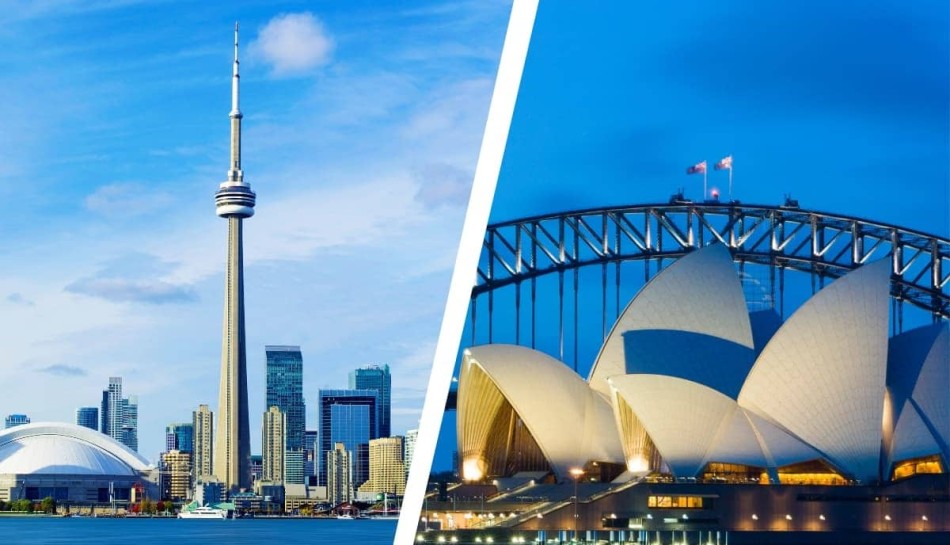If you’re looking to study overseas with the intention of immigrating after your studies, you might be considering Canada and Australia as potential destinations.
Over the course of 2024, both Canada and Australia have announced sweeping changes to their immigration systems.
Even after these changes, Canada and Australia have a lot to offer those looking for quality education, diverse and welcoming communities, and post-graduation pathways to permanent residency.
Here are the most significant differences the CIC news team has identified:
| Canada | Australia | |
| PR pathways | You can gain permanent status in Canada through a wide range of occupations, although occupations eligible for category-based draws have an advantage. | Getting permanent residence through the Skilled Independent Visa (subclass 189) is highly dependent on your occupation being under its Skilled Occupation List (SOL). |
| National work experience-based PR pathway(s) | Canadian Experience Class (CEC), a program under Express Entry for skilled workers with Canadian Experience. | No equivalent program. |
| Work hours on a study permit | Students can work unlimited hours on campus. | Limit on work hours applies equally to on-campus and off-campus work. |
| Study program restrictions for post-graduation work eligibility | For college graduates and other vocational program graduates, post-graduate work eligibility is restricted to graduates of programs aligned with in-demand occupations. | No program restrictions. |
In addition to the major differences above, we’ve also summarized detailed information on a variety of other factors, many of which are similar, but some of which have significant differences:
| Canada | Australia | |
| Number of Universities Named in QS World University Rankings 2025 Top 100 Ranking | 4 | 9 |
| Tuition cost (approximate) | 29,000 CAD to 81,000 CAD | 26,500 AUD to 113,000 AUD (24,509 CAD to 104,511 CAD) |
| Study permit cost | 150 CAD | 1,600 AUD (1,465 CAD) |
| Study permit processing time | Varies, approximately 3 months | Approximately 61 days (at time of publishing) |
| Hours international students can work while studying | 24h/week off campus during classes Unlimited on campus during classes Unlimited during breaks |
48h every 2 weeks during classes Unlimited during breaks No distinction between on-campus and off-campus |
| Maximum length of post-graduate work status | PGWP: up to three years | Temporary Graduate Visa – 2-3 years. |
| Popular PR Pathways for international students | Canadian Experience Class Provincial Nominee Program (PNP) |
Skilled Independent Visa Skilled Work Regional Visa |
| Eligible occupations for permanent status (for pathways listed above) | Express Entry programs: all skilled occupations. PNP: varies. In general, all skilled occupations, plus some lower-skilled occupations. |
Skilled Independent Visa: only those on the skilled occupation list. Skilled Work Regional Visa: only those on the skilled occupation list. |
Globally ranked educational institutions
Both Canada and Australia are home to world-renowned educational institutions.
The QS World University Rankings for 2025 lists the following four Canadian institutions within the top 100 spots:
- University of Toronto – 25th place.
- McGill University – 29th place.
- University of British Columbia – 38th place.
- University of Alberta – 96th place.
Meanwhile, many Australian institutions also feature on the list:
- The University of Melbourne – 13th place.
- The University of Sydney – 18th place.
- The University of New South Wales – 19th place.
- Australian National University – 30th place.
- Monash University – 37th place.
- The University of Queensland – 40th place.
- The University of Western Australia – 77th place.
- The University of Adelaide – 82nd place.
- University of Technology Sydney – 88th place.
Undergraduate tuition fees
Overall, international students can expect to pay similar tuition fees in Canada and Australia.
That said, the cost of tuition can vary greatly, depending on the program, school, and study location.
According to Statistics Canada, international undergraduate students in Canada can pay anywhere between 29,000 CAD to 81,000 CAD annually in 2024/2025.
In Australia, according to latest reports, top universities are set to increase tuition fees in 2025, charging between 26,500 AUD and 113,000 AUD (24,509 CAD to 104,511 CAD) anually.
Ease of getting a study permit
Study permit requirements between Canada and Australia are broadly similar. The main differences are:
- Canada has a lower cost for the study permit application, and lower financial support requirements.
- Australia has lower language testing requirements.
- Canada requires a provincial attestation letter (PAL).
- Australia has a genuine student requirement and also requires an Overseas Student Health Cover.
See the table below for more details:
<td class="column-1" style="box-sizing: initial; margin: 0px; padding: 15px 12px; border-top: 1p
| Documentation required | Canada | Australia |
| Proof of acceptance | From a designated learning institution (DLI) | From an institution registered on the Commonwealth Register of Institutions and Courses for Overseas Students (CRICOS) |
| Proof of identity | Required | Required |
| Financial support requirement | 20,635 CAD | 29,710 AUD (27,328 CAD) |
| Proof of financial support | Bank statements for the past 4 months | Bank statements |
| English language tests | Typically, an IELTS score of 6-6.5 for undergraduate programs | IELTS score 5.5 to 6.0 (or equivalent) |
















